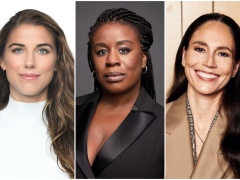
“The Last of Us Part II Remastered” is finally here, complete with a host of new features to draw in new fans and entice existing players.
Chief among them is No Return, a roguelike experience which allows users to complete a series of randomized encounters before facing off with a fearsome boss. It also gives fans their first opportunity to complete runs as previously unplayable characters like Dina, Jesse and Lev.
Game director Matthew Gallant sat down with PvNew to unpack the hotly anticipated title’s new additions, from accessibility upgrades to a series of scrapped levels showcasing the development process.
Some people may ask why a game released in 2020 needs a remaster already. Obviously, NaughtyDog released the remaster of the first game after just a year, so there’s a precedent – but why did the studio decide to release this now?
The comparison you just made to The Last of Us Remastered on the PS4 – to us, it’s a very similar kind of idea. When we made the original game, we were at the end of the console lifecycle of the PS3. We were experts at the time using that hardware, and we were just using it to the absolute limit.
When next gen hardware came along, we wanted to offer a remaster that could take advantage of that new power. So it’s very similar here: Part II came out at the end of the PS4 lifecycle. The PS5 comes along and has a little more overhead for us to be able to push out things like shadow quality, texture quality, LOD distances – stuff that’s pretty subtle.
Backing up, it’s just what we’ve done for many of our games. We want to be able to put these games out there so that players could pick them up and get the best current gen experience. We think these are games that are evergreen. They’re always finding new audiences. There’s always new players, and we want to give them the best experience possible.

On the PS5 specifically, I would call out the DualSense haptics. I’ll try not to nerd out too much. When we authored rumble on controllers in the past, that was always a tool that we had, but it was very coarse-grained. It was very blunt. You can really only use it for very big, impactful moments.
Haptics are a whole different ballgame. It’s almost like a little speaker inside the controller, so we can do very detailed reactions: rain, petting a dog. In the opening of the game, when Joel’s cleaning the guitar to give as a gift to Ellie, there’s little haptics on those moments of rubbing the cloth on the guitar frets. Those little details of immersion carry you along with the character. We were thrilled to be able to offer that.
When you found out you’d be taking the lead on this project, what were your biggest goals?
Right off the bat, there were table stakes here. Boosting up the art settings, adding the haptics, taking advantage of the fast PS5loading: that was just the known proposition of what this project was. What was really interesting about was that we had this capability to say, “Well, what else can we offer players here? What would be cool?”
That’s whatled us in the direction of offering thelost levelssay, to give players a behind the scenes look of what it looks like to make a game. Game developers are often very secretive in that they’d like to conceal the magic or hold their cards. You don’t get to see games when they’re very early in development. So that was one thing we had in our pocket.

Another thing that we had is that the designers who worked on the guitar game in the original game – I would affectionatelycall themmusic nerds – had a lot of really cool ideas. The new ability to add all sorts of photo mode filters over the guitar minigame, to be able to swap characters, swap locations, audio filters and apply wild reverb and distortion was really exciting to get to play with.
We knew we had these really robust combat and AI systems, enemy types, upgrades and guns. But then in the main story, that’s one way that we can use them. We could take those incredibly robust systems and offer a different experience with them, more like an arcade mode. No Return let us throw players into situations that they might never have encountered before.
Let’s dive into No Return in more detail. The challenges and random encounters make it really addicting – how did that structure take shape?
It feels like, in the last five years or so, roguelikes have just had this amazing renaissance. Designers have realized what a rich design space that is. It’s a very flexible container. And I think what we saw with The Last of Us was two things in particular. The first one is that sense of stakes, because when you’re playing a combat encounter, you might be under pressure and tension, but you know in the back of your head that you have a checkpoint. The penalty for death is not that bad.
I find that in a roguelike, when you’re four encounters deep on a run, and you’re sitting behind cover with low health, that gets your heart racing. That gets your palms sweaty and really adds a sense of excitement to the game and pushes you to think on the fly and deal with these desperate situations.

The other thing that I think roguelikes do really well is when you die, and you’re able to randomize all the variables again to shake up the bag and offer a completely new challenge every time. So it means that even you know, as you’re making your way through these things, we’re always able to try and mix up and throw new challenges at you. Different combinations of enemy factions and maps and mods.
You also mentioned the lost levels, which give a glimpse of scenes that were ultimately cut from the final game. Why were those important to bring to this version?
You’re getting to see the raw clay that becomes a NaughtyDog game when it’s still in those crude stages. We have these floating commentary nodes where the players can press a button and hear from the designers that worked on the level.
It really gets into the nitty gritty of how we were trying to direct the players eye to spot this next objective. Here’s where we were trying to misdirect. Here’s the narrative and motion that we wanted to land here. This is the theme that we were connecting to.It’sso much richer when you get that commentary and that context with them.

When you look at the final product, what are you most proud of in the remaster?
One of the things that I was involved with for the original game was accessibility. We were very excited to make a very thoroughly accessible experience. We had a ton of time to bring in consultants. I think it was noteworthy for being a game that was completable by someone who was completely blind.
In the remasters, we have audio descriptions for cinematics. That was a feature that we added on to The Last of Us Part I. We have parity because we’ve added that to Part II. Now there’s that additional rich story context, and understanding that there was this unspoken glance between two characters that a blind player couldn’t hear in the dialogue. I’m really thrilled to take a game that I think was already very thoroughly accessible and to add even more.
This interview has been edited for length and clarity.






